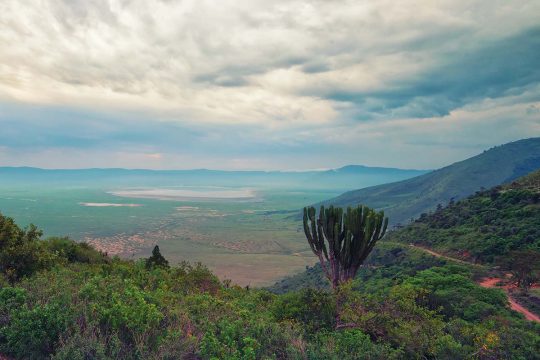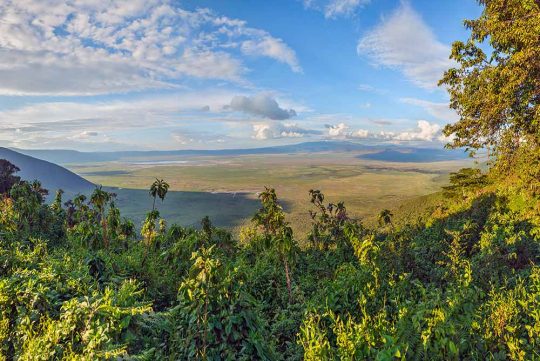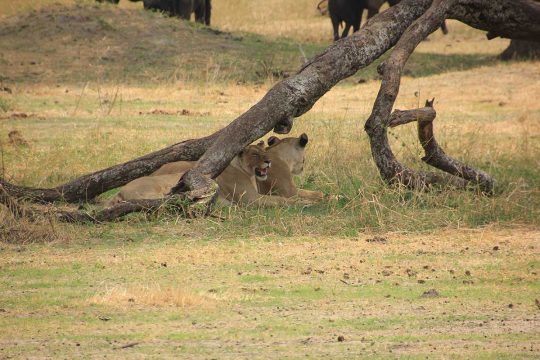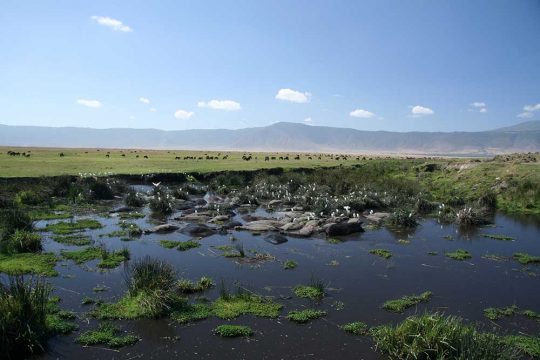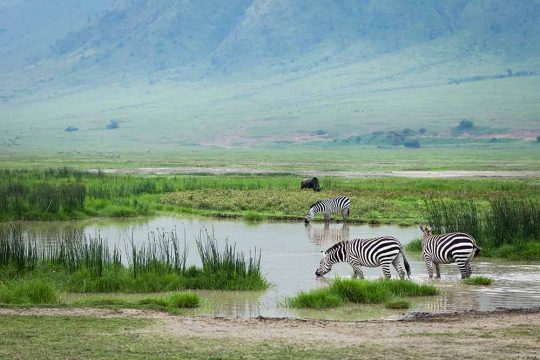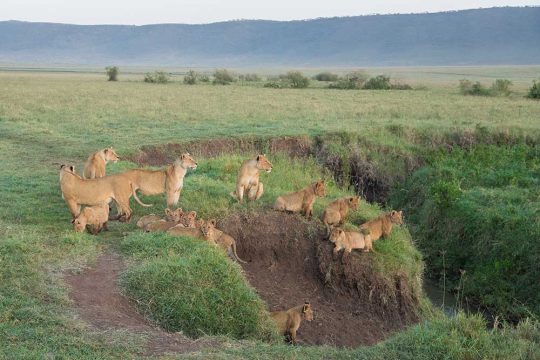Ngorongoro Conservation Area
Are you thinking to go on safari at Ngorongoro?
Talk to our experts about the perfect planning for your holiday.
Error: Contact form not found.
- About Ngorongoro
- Interesting facts about Ngorongoro
- Best Time to Visit Ngorongoro
- Getting to Ngorongoro
- Things to see in Ngorongoro
- Things to do in Ngorongoro
- Where to Stay in Ngorongoro
- Weather & Climate
Welcome to Ngorongoro Conservation Area, a cradle of life!
About Ngorongoro Conservation Area
The Ngorongoro Crater is a spectacular destination in Africa to see the Big Five animals. It is the world’s largest intact volcanic caldera and the best destination to spot the big games in Africa. Over 2 million years ago, Ngorongoro was a volcanic mountain with an equal height to the roof of Africa “The mount Kilimanjaro”. It was then transformed into a gigantic inactive volcano as a result of the eruption. The collapse of the highest mountain many years ago has made us today speak of a bowl measuring 20 kilometers wide with sides up to 610 meters deep.
The Ngorongoro Crater and stunning landscape around, together form one of the World’s most beautiful tourist destinations. It is a great point to start your Tanzania safari adventure. It offers most of the best wildlife viewing opportunities during your Safari. Many northern Tanzania Safari itineraries and probably all should include a visit to Ngorongoro Crater. It was chosen as one of Africa’s Seven Natural Wonders and is one of the most magnificent natural wildlife safari destinations in the world due to its abundant wildlife and scenic landscape.
Famous for:
Big Five animals such as Rhinos, Leopards, Elephants, Lions, and Buffalos
Interesting Facts About Ngorongoro Conservation Area
One of The Sevens Natural Wonders of Africa
- If it had not collapsed, today Ngorongoro would be a mountain similar size to Mount Kilimanjaro
- Known as the Garden of Eden due to its beauty, it’s also one of the Sevens Natural Wonders of Africa
- More than 80,000 people and 30,000 animals ranging from leopard, cheetah, elephant, and hyena to warthog, buffalo, and impala live in the conservation area in harmony.
- Giraffes are not present as they cannot walk down the steep sides of the crater. Nonetheless, they’re available around the crater rim.
UNESCO World Heritage Site
- At more than 600 meters deep, Ngorongoro is the biggest volcanic caldera in the world
- The Ngorongoro Crater was designated as a UNESCO World Heritage Site in 1979
- Inside the Ngorongoro Conservation Area lies the world celebrated Olduvai Gorge, where the remains of probably among the earliest human beings were discovered by Dr. Leakey and (Mrs. Leaky.).
- More than 800,000 people from all over the world come and explore the reputed Ngorongoro every year.
- Some of the world’s (biggest celebrities) have paid a visit to Ngorongoro. That includes;- Prince William, Bill Clinton, and the Queen of Denmark just to name a few.
- Ever watched the Oscar-winning movie named Out of Africa was filmed partly in the Ngorongoro Conservation Area.
Best Time to Visit
Ngorongoro is among the few destinations in the world where wildlife viewing is at its best the whole year-round.
Since the wild animals stay in the crater all year round, indeed, there is no good or bad time to visit this natural wonder.
However, during the peak season the crater floor might get very busy with safari vehicles, it can be more pleasant to visit during the off-season to avoid too many crowds.
Sufficient water levels in Lake Magadi result in higher concentrations of flamingos. Whenever you visit Ngorongoro crater, exceptional safari experiences are guaranteed.
All in all, you can decide to visit Ngorongoro any month of the year. You won’t regret your choice as almost the majority of crater animals are residents and they don’t move too much as everything they need is available.
Getting to Ngorongoro Conservation Area
Two airways lead you to Tanzania & Ngorongoro
Kilimanjaro International Airport (JRO)
Julius Nyerere International Airport (JNIA)
However, for your safari goals, JRO serves you best.
Kilimanjaro International Airport (JRO)
Kilimanjaro International Airport (JRO) is situated 46km/29mi east of Arusha, the gateway of Tanzania’s most popular Northern safari circuit including Ngorongoro.
From Arusha, it is a short scenic 3 – 3.5 hours drive to Ngorongoro.
Julius Nyerere International Airport (JNIA)
Tanzania’s main airport is Julius Nyerere International Airport (DAR) located 13km/8mi southwest of Dar es Salaam. This is the entry point for visitors to the southern parks (Mikumi, Selous, and Ruaha national parks).
Moving on from Dar es Salaam to Arusha you can fly or drive. However, a drive will take 10-12 hours via public transport. You can also get a transfer from Dar es Salaam to Arusha via private vehicle, however…this is expensive.
There’re local flights from Dar es Salaam to Arusha which land at JRO Airport or Arusha Airport.
We usually advise guests to minimize unnecessary costs by flying to JRO airport. The only exception to this is when someone has to go to Dar es Salaam first for various reasons.
Things to See
Wildlife of Ngorongoro Crater
The Ngorongoro Crater is the best place in Africa for (spotting) the big five. An area acts as a perfect location to spot black rhinos and some of the largest tusker elephants left on the African continent.
The crater is also home to good populations of big cats such as lions and leopards without forgetting the herds of wildebeest, buffalo, and zebra. Other wildlife here includes serval cats, cheetah, hyenas, jackal, Grant’s and Thompson’s gazelle.
Birds of Ngorongoro Crater
Ngorongoro has more than 400 species of birds such as ostrich, white pelican, flamingo, and many others. Other species of birds can be viewed on Lake Magadi within the crater, Lake Ndutu which is outside the crater as well as in the Empakai Crater Lake.
Plants of Ngorongoro Crater
The presence of natural forests in the crater ensures a sufficient number of plants and flowers within the area. The scenic forest in the crater consists of lush vegetation, desert plants, scrub heath, peacock flowers, yellow wood, and sweet olive. Other plants include acacia, yellow fever trees, Africana trees, zebrawood, and pillar wood.
Ngorongoro crater has got a lot of things to do and the best thing you would like the most is that you will explore the activities within some hours of the day with greater satisfaction than ever due to the abundance of wildlife.
The following are among the best things to do when you visit Ngorongoro Crater:
- Game Drive
- Guided Nature Walks
- Bird watching Safari
- Big five spotting
However, if you would like a full range of activities the wider area of Ngorongoro Conservation Area is highly recommended, including walking tours, trekking, cultural exploration at Olduvai Gorge Museum & Laitoli footprints, excursions to Empakai & Olmoti Craters, and a visit to Masai and other tribes.
Weather & Climate
The weather may get cold in Ngorongoro due to its high altitudes hence warm clothes are highly recommended.
Dry season: from June to October
Wet Season: from November to December
Mixed dry weather and the wet season: January & February
Wetter Season: from March to May
If you liked Ngorongoro Conservation Area, you might also like Tarangire National Park.
For more content like this, please follow us on Instagram.
Do you need expert tips on planning for your next safari in Africa?
Share your email here
[mc4wp_form id=”29279″]

